Caterpillars have soft bodies, making them extremely vulnerable to predation and parasitism. They are unable to escape if attacked, so have evolved numerous survival mechanisms to deal with their enemies which include birds, reptiles, amphibians, dragonflies, predatory / parasitoid wasps, robber flies, crickets and spiders. In tropical regions they also fall victim to ants, mantises, monkeys and numerous other threats.
Armature
Larvae in some subfamilies e.g. Satyrinae, Hesperiinae, Notodontinae, Noctuinae, Geometrinae and Sphinginae are normally devoid of hairs. Those in many other subfamilies including Lasiocampinae, Arctiinae, Lymantridae, Acronictinae and Hemileucinae bear hair-like setae. Sometimes these are sparse but in some species such as the ‘woolly bear’ Garden Tiger moth Arctia caja they are very long and dense, giving the larva a furry appearance.
The thick coat of hair makes it more difficult for a bird or reptile to swallow a larva. It also has the added bonus of cushioning it in the event of a fall. Additionally hair traps pockets of air around the caterpillar’s body, allowing it to survive if it has the misfortune to fall into a puddle. Caterpillars of Arctia caja for example can survive periods of several days submerged in water.
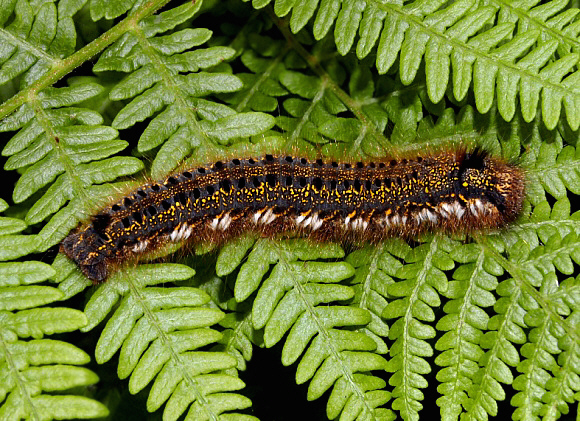 larva of Drinker moth Euthrix potatoria ( Lasiocampidae ), England – Adrian Hoskins
larva of Drinker moth Euthrix potatoria ( Lasiocampidae ), England – Adrian Hoskins
The hairs of moths in the families Lasiocampidae and Lymantridae often have irritating properties. In the case of the Drinker moth Euthrix potatoria they do little more than cause a mild itch, but the hairs shed by the larva of the Brown-tail moth Euproctis chrysorrhoea are rather more troublesome and can cause a severe rash on human skin. It is generally the case however that larvae from the temperate regions of the world are fairly safe to handle. In the tropics it is a very different story, and all hairy or spiky larvae should be treated with caution.
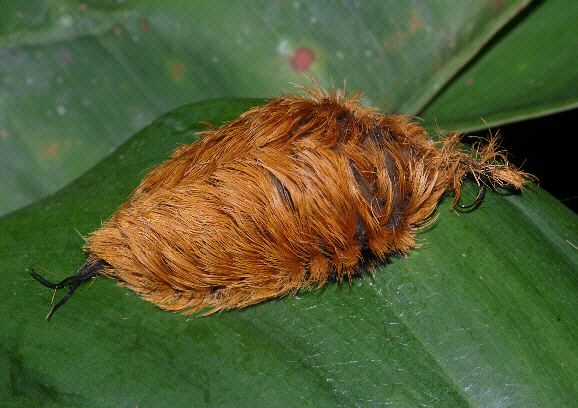 Caterpillar of Flannel moth ( Megalopygidae ), Peru © Adrian Hoskins
Caterpillar of Flannel moth ( Megalopygidae ), Peru © Adrian Hoskins
The larvae of moths in the family Megalopygidae look fluffy and almost invite you to handle them, but hidden beneath the soft hairs are a series of sharp spines. If the larvae are handled the spines break, releasing a chemical which causes excruciating pain.
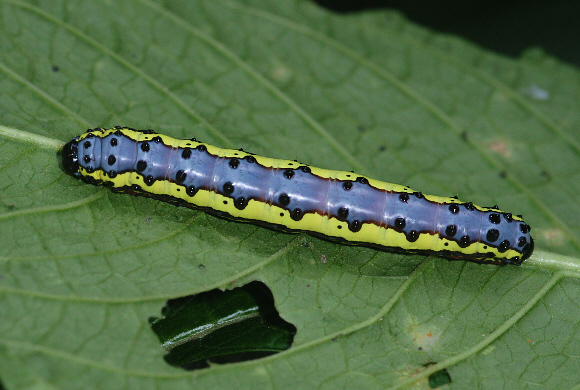 Unidentified moth larva, Peruvian Andes © Adrian Hoskins
Unidentified moth larva, Peruvian Andes © Adrian Hoskins
Many caterpillars, such as the unidentified species illustrated above, use bright patterns and colours to warn enemies that they are distasteful or poisonous. Others including those of the Nymphalinae, Heliconiinae, Limacodidae and Saturniidae are armed with rows of extraordinary multi-branched spikes and horns. These are enough to deter many birds from attacking, and no doubt also offer a degree of protection against wasps, ants and other insect predators.
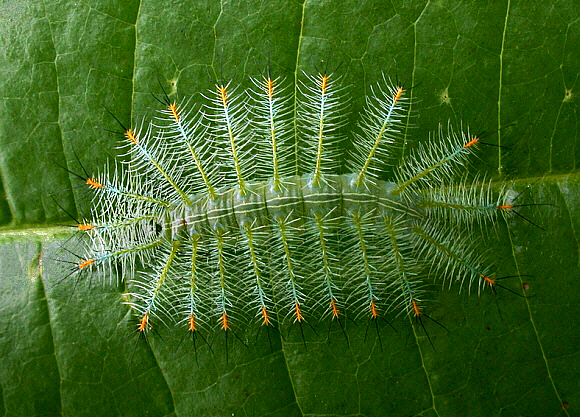 Lexias pardalis, West Malaysia – Gan Cheong Weei
Lexias pardalis, West Malaysia – Gan Cheong Weei
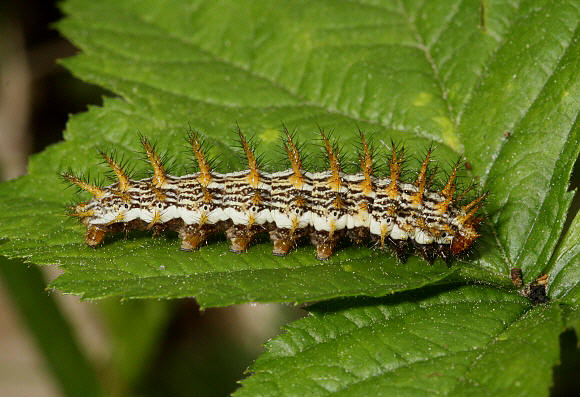 Brenthis daphne, Hungary – Peter Bruce-Jones
Brenthis daphne, Hungary – Peter Bruce-Jones
Spikes, hairs and other armature are most pronounced in young larvae which feed communally, so it seems likely that one of their functions may be to protect them against cannibalism.
In most species the spines are harmless or cause only mild irritation in humans, but in at least one Saturniidae species they can inflict a potentially lethal sting. The well camouflaged spiked larvae of Lonomia obliqua are often found clustered on tree trunks in Amazonia.
There have been thousands of cases where people have unwittingly touching or rubbed an arm against them. The effects can be extreme, including massive intercranial haemorrhaging and kidney failure.
Lonomia larvae are a frequent cause of death in southern Brazil – 354 people died between 1989-2005. The fatality rate is about 1.7% – roughly equivalent to that of rattlesnake bites.

The Bullseye moth larva Automeris liberia ( Saturniidae ) can inflict a painful sting – Adrian Hoskins
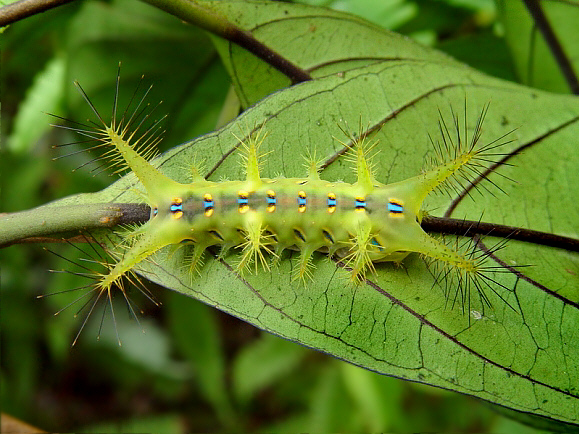 unidentified Limacodidae species, West Malaysia © Gan Cheong Weei
unidentified Limacodidae species, West Malaysia © Gan Cheong Weei
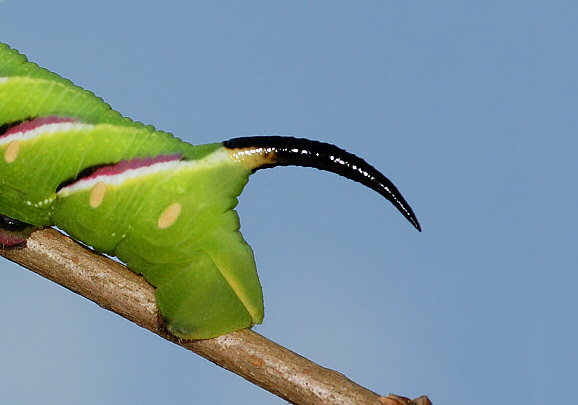 Larva of Sphinx ligustri ( Sphingidae ), showing the spiracles and tail horn – Adrian Hoskins
Larva of Sphinx ligustri ( Sphingidae ), showing the spiracles and tail horn – Adrian Hoskins
Many people believe you can be stung by the ‘hornworm’ larvae of moths in the family Sphingidae but this is entirely untrue. The caterpillar is completely harmless, and edible to birds.
Mimicry
Diematic mimicry is quite a common form of defence in caterpillars as well as in adult butterflies and moths. The larvae of many Swallowtail species including Papilio polymnester and Papilio troilus have a pair of false eye-spots on the thoracic segments. Many hawkmoth larvae such as Deilephila elpenor and Hippotion celerio employ the same strategy.
When alarmed the larvae of these species puff up the thoracic segments causing the eye-spots to expand. This is considered to be a form of diematic defence in which the larvae are mimicking the heads of snakes.
Camouflage and disguise
Many species use camouflage to escape detection, and are thus often coloured green to match the leaves on which they rest. The Lasiocampidae species illustrated below is very well camouflaged at rest among lichens and mosses. Others are disguised as flowers, feathers, twigs or bird droppings.
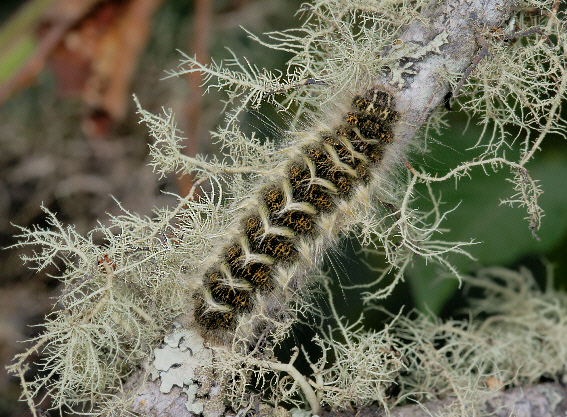 unidentified Lasiocampidae larva, Peruvian Andes, 2800m © Adrian Hoskins
unidentified Lasiocampidae larva, Peruvian Andes, 2800m © Adrian Hoskins
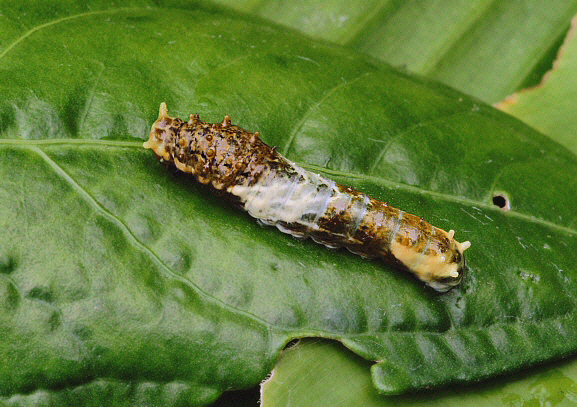 Heraclides thoas, disguised as a bird dropping. Rio Alto Madre de Dios, Peru – Adrian Hoskins
Heraclides thoas, disguised as a bird dropping. Rio Alto Madre de Dios, Peru – Adrian Hoskins
Gregarious behaviour and larval webs
Generally speaking larvae which feed as solitary individuals tend to be palatable to predators, and rely primarily on camouflage – colours, patterns and textures which help them to avoid detection. Larvae which feed gregariously tend to be unpalatable or toxic to predators. They often advertise their toxicity with bold aposematic colours – a seething mass of brightly coloured wriggling larvae is much more likely to deter a potential predator than a single larva could.
Gregarious behaviour also serves other purposes, e.g. a group of larva can quickly construct a communal silk shelter in which they can hide from predators and parasitoids. These larval shelters or nests also protect them from the ravages of extreme weather such as heavy rain, flooding and high winds.
Reflex bleeding
If molested, some species such as the caterpillar of the Peacock butterfly Inachis io react by ‘reflex bleeding’, i.e. they spurt a foul smelling and noxious fluid from glands behind the head. This acts as a warning to wasps, spiders and predatory birds that they are distasteful and should be left alone.
Molestation also causes the caterpillars to wriggle violently and drop from their leaf into the herbage below, presumably as a defence against parasitoid wasps or flies. Nevertheless at least 90% of Peacock larvae fall victim to attack by the Tachinid fly Zenilla vulgaris. Other Tachinids including Pelatachina tibialis, Sturmia bella and Phryxe vulgaris are also recorded as parasitizing Inachis io.
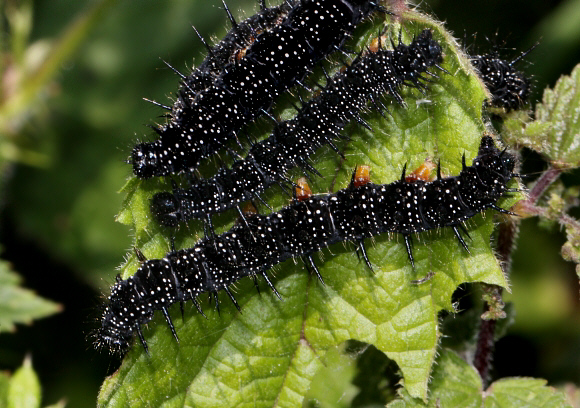 Inachis io, 5th instar larva, Hungerford, Berkshire – Adrian Hoskins
Inachis io, 5th instar larva, Hungerford, Berkshire – Adrian Hoskins
Multiple defence strategies
Birds rely primarily on sight to locate prey, so the evolution of visually directed defences such as camouflage, disguise and aposematic colouration reduces the likelihood of larvae being eaten.
These strategies work quite effectively against vertebrates but they provide no protection against invertebrates such as spiders, wasps, bugs and ants, which rely primarily on smell to locate their prey. The larvae of many species have consequently evolved a twin pronged defence strategy:The larva of the Puss moth Cerura vinula uses disguise as it’s first line of defence.
When at rest its disruptive pattern of green and dark purplish-brown gives it the appearance of a curled up leaf with darkened edges. This illusion is reinforced by the presence of a pair of tail prongs which are held together, simulating a leaf stalk.
The disguise helps it avoid being spotted by birds, but offers it no protection against parasitoid wasps that track victims down by scent. To deal with wasp attacks it switches to active defence mode. When molested it rears up and retracts its head. This causes the prothorax to expand, exposing a bright crimson ‘false head’, complete with prominent false eyes.
If this is insufficient to deter an attacking wasp the larva then spreads its tail prongs and everts a pair of whip-like threads which are waved angrily. Even this may not be enough to deter a wasp however so a last resort defence the larva can eject formic acid – the same chemical used by bees, wasps and ants in their stings.
Most Swallowtail larvae are palatable to birds and employ cryptic colours and patterns as their first line of defence. If discovered however they activate additional defences. Many for example have a pair of ‘false eye’ markings on the thoracic segments, and can inhale air through the spiracles to puff up the thorax, emphasising their threatening appearance.
This is often enough to deter birds from attacking. Molestation by insect predators and parasitoids however elicits a different response from the larvae. In this instance they evert the ‘osmaterium’ behind their heads. This discharges airborne isobutyric and 2-methylbutyric acids which has been shown to repel ants and Homopteran predators. It also deters oviposition by parasitoid wasps and flies.
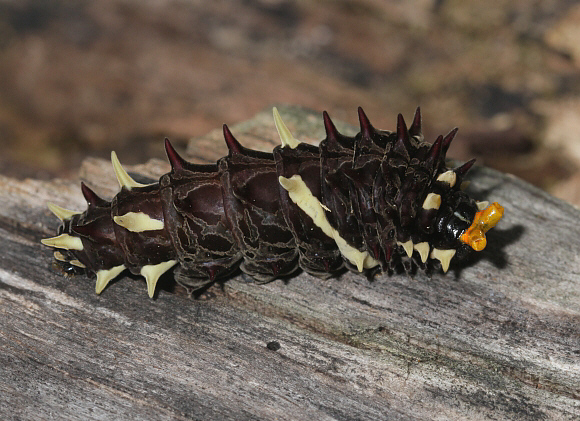
Peruvian Cattleheart larva Parides anchises with osmaterium extended – Adrian Hoskins
Geometrid moth larvae use disguise as their primary defence – they look just like tiny twigs, and reinforce this similarity by stretching out their bodies in a straight line so that they project twig-like from a sprig of their foodplant.
If molested they release grip on the sprig, dropping instantly from a bungee-cord of silk. They dangle at the end of this thread until the attacker has moved on. After a while they haul themselves back up, consuming the silk thread as they do so.
Caterpillars of species such as the Small Tortoiseshell Aglais urticae, the Tiger moth Arctia caja and the Fox moth Macrothylacia rubi try to escape when they perceive a threat. If alarmed they simply roll into a ball and drop to the ground.
Aglais larvae are covered in spines. Arctia and Macrothylacia larvae are hairy. In both cases birds remember from previous experiences that such larvae are difficult or uncomfortable to swallow, and sight-reject them.
